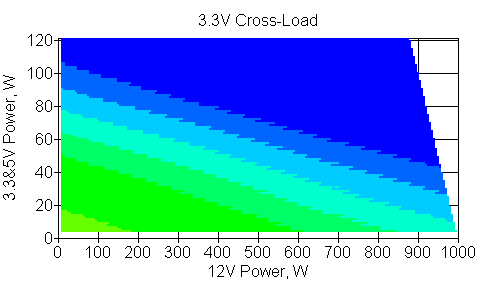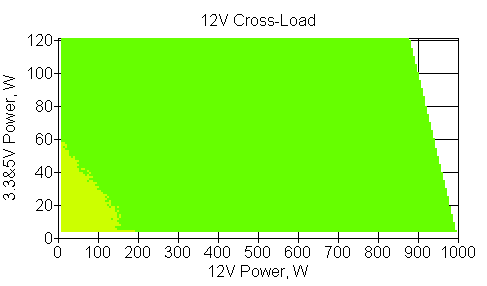This time we will look at one of the power supplies available on the market under the Formula brand. The model with the Formula VL-1000G5-MOD trademark has a high power of kilowatts. The power supply is 80Plus Gold certified, which makes it a mid-budget solution for such a high-power power supply segment. Despite its catalog name, the power supply demonstrated excellent performance and passed all tests without failure.
Finding the website of the manufacturer of the Formula VL-1000G5-MOD power supply turned out to be difficult, since the search results in search engines were not very informative. However, the website address was found on the packaging and the product itself (inside).
One of the interesting features of this power supply is its ventilation grille. Unlike conventional wire grilles, it is made in the form of a removable plate with holes and its own fastening with screws. This means that to access the fan you need to remove a total of 8 screws, instead of four as in conventional models. It should be noted that this grille design creates additional aerodynamic drag due to partial overlap of the holes by the ribs.
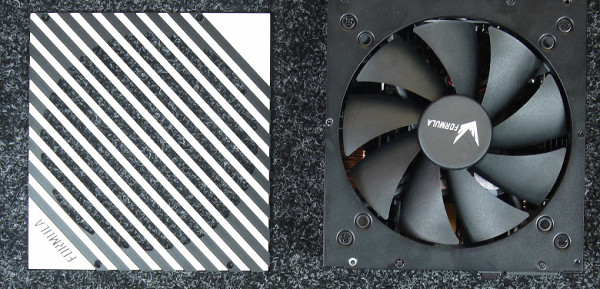
The cooling system operates exclusively in hybrid mode, in which the fan may remain inactive under certain, very rare conditions.
The length of the power supply housing is approximately 160 mm, to which another 15-20 mm should be added for ease of cable management. Therefore, when installing, you should focus on a total length of about 180 mm. For power supplies of this power, these dimensions can be considered very compact.

The packaging of the power supply is made of durable cardboard with a matte finish, which shows an illustration of the device itself. Black and gray shades dominate the design.
Characteristics
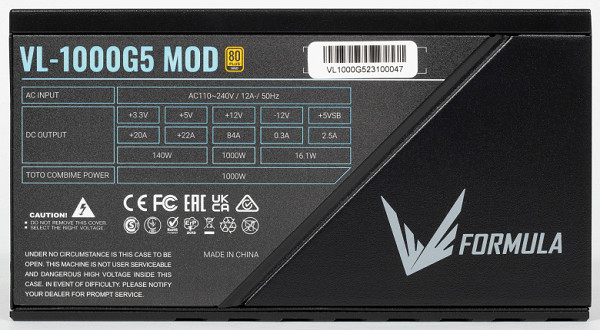
All the necessary parameters are fully indicated on the power supply case, including the power of the +12VDC bus, which is 1000 W. This corresponds to 100% of full power, which is a high figure.
Wires and connectors

| Connector name | Number of connectors | Notes |
|---|---|---|
| 24 pin Main Power Connector | 1 | collapsible |
| 4 pin 12V Power Connector | — | |
| 8 pin SSI Processor Connector | 2 | collapsible |
| 6 pin PCIe 1.0 VGA Power Connector | — | |
| 8 pin PCIe 2.0 VGA Power Connector | 6 | on 3 cords |
| 16 pin PCIe 5.0 VGA Power Connector | 1 | |
| 4 pin Peripheral Connector | 4 | |
| 15 pin Serial ATA Connector | 8 | on 3 cords |
| 4 pin Floppy Drive Connector | — |
Length of wires to power connectors
Without exception, all wires are modular, that is, they can be removed, leaving only those that are necessary for a particular system.
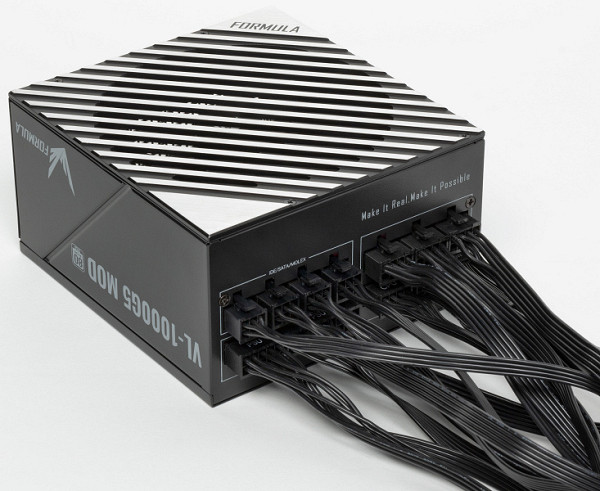
- One cord to the main ATX connector is 60 cm long.
- Two cords to the 8 pin SSI processor socket are 70 cm long each.
- Three cords to the first power connector of the PCIe 2.0 VGA Power Connector video card are 50 cm long, and to the second similar connector — 65 cm.
- One cord to the PCIe 5.0 VGA Power Connector is 60 cm long.
- Two cords to the first SATA Power Connector are 50 cm long, to the second — 65 cm, and to the third similar connector — 80 cm.
- One cord to the first SATA Power Connector is 50 cm long, to the second — 65 cm, and to the Peripheral Connector (Molex) — 80 cm.
- One cord to the first Peripheral Connector (Molex) is 50 cm long, to the second — 65 cm, and to the third similar connector — 80 cm.
The length of the wires is sufficient for comfortable use in full tower and larger cases, as well as in cases with a bottom-mounted power supply up to 55 cm in height. Thanks to the standard ability to connect a video card with the new PCIe 5.0 power connector without the use of adapters, this power supply model provides additional opportunities for modern systems.
Circuit design and cooling
The power supply is equipped with an active power factor correction and supports a wide input voltage range from 100 to 240 volts. This ensures stable operation even at low voltage levels in the electrical network below established standards.
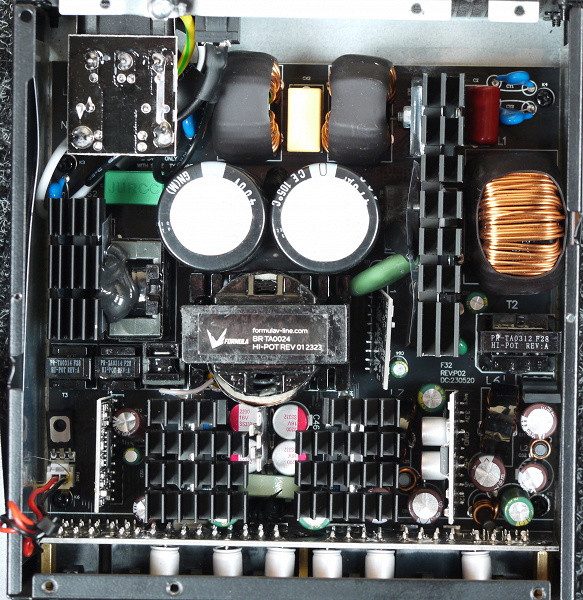
The design of the power supply follows modern trends: there is an active power factor corrector, a synchronous rectifier for the +12VDC channel, as well as separate pulse converters for the +3.3VDC and +5VDC lines.
Elements of semiconductor high-voltage circuits are placed on two radiators, including the input rectifier. The rectifier elements are located on the front side of the main printed circuit board adjacent to the radiators.
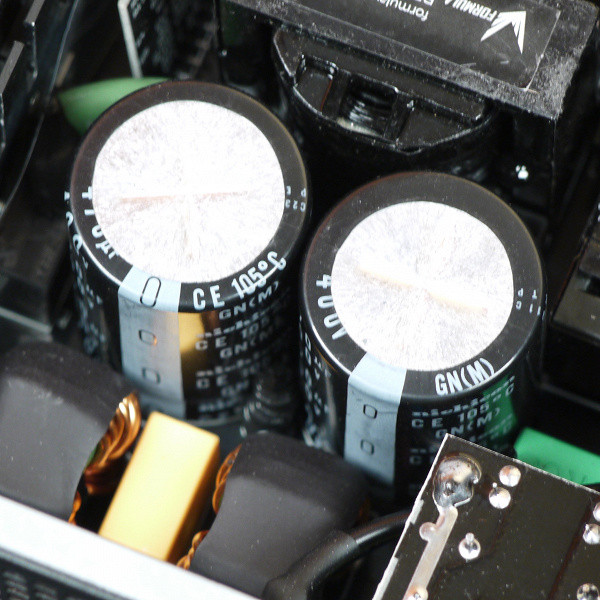
The +3.3VDC and +5VDC power supplies are located on a separate daughter printed circuit board and do not have additional heat sinks, which is standard practice for power supplies with active cooling.
The device uses high quality high voltage capacitors from Nichicon.
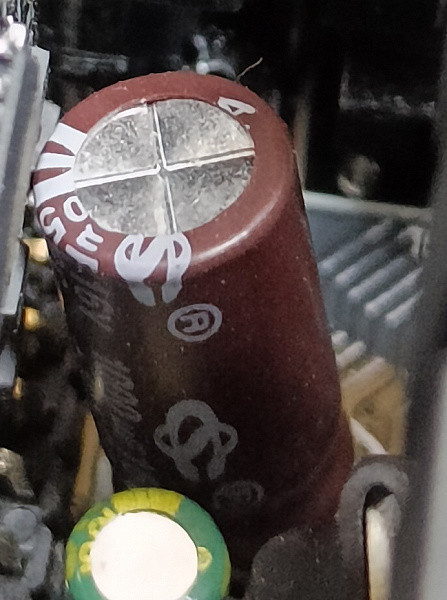
Low-voltage capacitors are represented by products under an unknown brand.
A large number of polymer capacitors are also installed here.
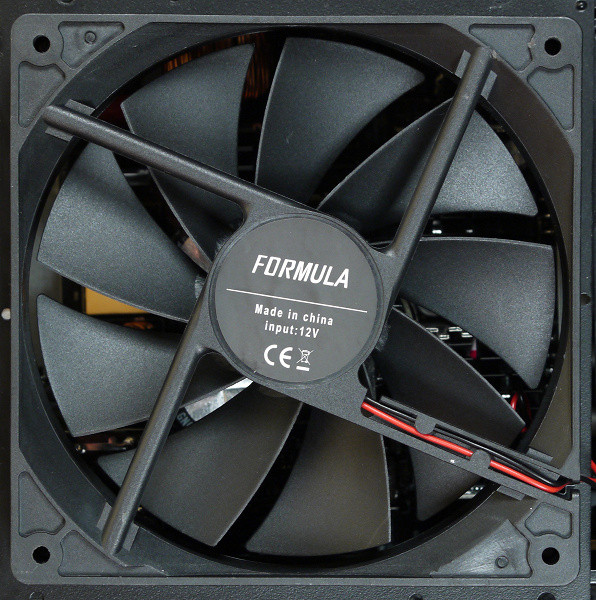
The power supply has a fan whose characteristics are unknown. This is supposed to be a sleeve bearing fan, which is one of the most affordable options. The fan is connected via a two-wire connector.
Electrical Characteristics Measurement
Next, we begin to study the electrical characteristics of the power source using a multifunctional stand and other equipment.
The deviation of output voltages from the nominal value is coded in the following colors:
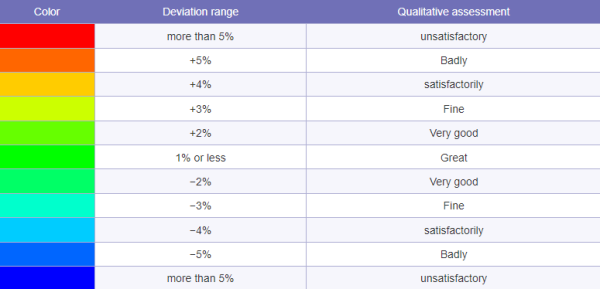
Operating at maximum power
The first test step is to operate the power supply at maximum power for an extended period of time. This test reliably confirms the functionality of the power supply.

Cross-load characteristic
At the next stage of instrumental testing, the cross-load characteristic (CLC) is constructed and represented on a quarter-plane. This plane is limited by the maximum power on the 3.3&5 V bus on one side (along the ordinate) and the maximum power on the 12 V bus on the other side (along the x-axis). At each point, the measured voltage value is indicated by a color marker depending on the deviation from the nominal value.
KNH analysis allows you to determine the permissible load level for the tested power supply, especially on the +12VDC channel. In this case, deviations of the effective voltage values from the nominal value via the +12VDC channel do not exceed 3% over the entire power range. This is a significantly good result, considering that the deviation in the higher direction is observed at low loads, and not vice versa, which is typical for some manufacturers who deliberately increase the 12 V voltage level in their power supplies.
With a typical power distribution across channels, deviations from the nominal do not exceed 4% for the +3.3VDC channel, 3% for the +5VDC channel and 3% for the +12VDC channel. Deviations on the +3.3VDC channel turn out to be quite significant; savings were probably made here on its implementation, although the needs for this voltage in modern computers are insignificant.
Load capacity
The next stage of testing is aimed at determining the maximum power that can be transmitted through the corresponding connectors, subject to a normalized voltage deviation of 3 or 5 percent from the nominal value.

In the case of a video card with a single power connector, the maximum power over the +12VDC channel is at least 150 W with a deviation within 3%.

In the case of a video card with two power connectors when using one power cord, the maximum power over the +12VDC channel is at least 250 W with a deviation within 3%.

When using two power cords for a video card with two power connectors, the maximum power over the +12VDC channel is at least 350 W with a deviation within 3%, which makes it possible to use very powerful video cards.

When loaded through three PCIe 2.0 connectors, the maximum power over the +12VDC channel is at least 650 W with a deviation within 3%.

When loaded through the processor power connector, the maximum power through the +12VDC channel is at least 250 W with a deviation within 3%. This is quite enough for typical systems that have only one connector on the motherboard for powering the processor.

When loaded through two processor power connectors, the maximum power via the +12VDC channel is about 500 W with a deviation within 3%.

In the case of a motherboard, the maximum power on the +12VDC channel is at least 150 W with a deviation within 3%. At the same time, the board itself consumes within 10 W via this channel. High power may be required to power expansion cards, for example, for video cards without an additional power connector, which typically have a consumption of around 75 W. However, it is unlikely that anyone will use such video cards with this power supply. Overall the results are really good and there are no major complaints.
Cost-effective and efficient
When assessing the efficiency of a computer power supply, there are two main approaches you can take. The first approach is to evaluate the power supply as a separate electrical energy converter and then try to minimize the resistance of the electrical energy transmission line from the power supply to the load. The second approach is aimed at determining the efficiency of a computer power supply by calculating the power dissipation when converting electricity and transmitting it to end consumers. In this case, both the absolute values of energy consumed by the power source over a certain period of time and the cost of consumed electricity are taken into account.
The first approach involves evaluating a computer power supply as an energy converter, which involves analyzing the efficiency of electrical energy conversion, measured by coefficient of performance (COP). Although high efficiency can be considered an indicator of the quality and efficiency of a power supply, its impact on the functioning of the system unit is limited and does not affect its performance or other characteristics. On the other hand, the second approach to assessing the efficiency of a power supply allows you to determine the real energy costs when using it, which can be more informative for the end user.
To assess the efficiency of various power supply models, you can use the calculation of power dissipation when converting electricity and transmitting it to end consumers. The resulting value can be converted into the cost of electricity over a certain period of time, which will allow you to compare the economic feasibility of using different models of power supplies.
Thus, to objectively assess the efficiency of a computer power supply, it is recommended to take into account both its efficiency in the form of efficiency, as well as the power dissipated during the conversion of electricity and its cost over a certain period of time.
| Load through connectors | 12VDC, W | 5VDC, W | 3.3VDC, W | Total power, W |
|---|---|---|---|---|
| main ATX, processor (12 V), SATA | 5 | 5 | 5 | 15 |
| main ATX, processor (12 V), SATA | 80 | 15 | 5 | 100 |
| main ATX, processor (12 V), SATA | 180 | 15 | 5 | 200 |
| Main ATX, CPU (12V), 6-pin PCIe, SATA | 380 | 15 | 5 | 400 |
| Main ATX, CPU (12V), 6-pin PCIe (1 cord with 2 connectors), SATA | 480 | 15 | 5 | 500 |
| main ATX, processor (12 V), 6-pin PCIe (2 cords per 1 connector), SATA | 480 | 15 | 5 | 500 |
| Main ATX, CPU (12 V), 6-pin PCIe (2 cords x 2 connectors), SATA | 730 | 15 | 5 | 750 |
The results obtained look like this:
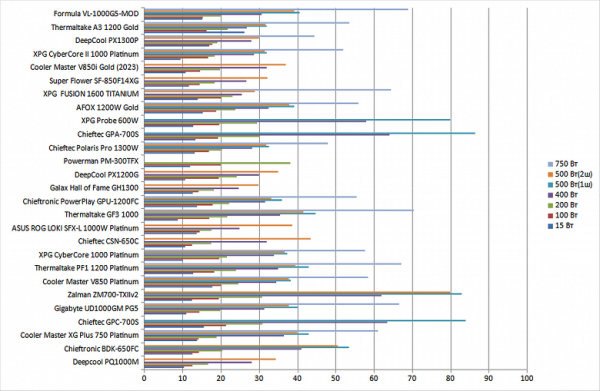
| Power dissipation, W | 15 W | 100 W | 200 W | 400 W | 500 W (1 cord) | 500 W (2 cords) | 750 W |
|---|---|---|---|---|---|---|---|
| Cooler Master V1000 Platinum (2020) | 19.8 | 21.0 | 25.5 | 38.0 | 43.5 | 41.0 | 55.3 |
| Thermaltake TF1 1550 | 13.8 | 15.1 | 17.0 | 24.2 | 30.0 | 42.0 | |
| Thermaltake GF1 1000 | 15.2 | 18.1 | 21.5 | 31.5 | 38.0 | 37.3 | 65.0 |
| Chieftec PPS-1050FC | 10.8 | 13.0 | 17.4 | 29.1 | 35.1 | 34.6 | 58.0 |
| Deepcool PQ1000M | 10.4 | 12.6 | 16.7 | 28.1 | 34.4 | ||
| Gigabyte UD1000GM PG5 | 11.0 | 14.4 | 19.9 | 31.4 | 40.1 | 37.8 | 66.6 |
| Thermaltake PF1 1200 Platinum | 12.8 | 18.3 | 24.0 | 35.0 | 43.0 | 39.5 | 67.2 |
| XPG CyberCore 1000 Platinum | 10.1 | 19.6 | 21.6 | 33.9 | 37.4 | 36.7 | 57.7 |
| Asus ROG Loki SFX-L 1000W Platinum | 13.7 | 14.5 | 17.6 | 24.9 | 38.7 | ||
| Thermaltake GF3 1000 | 8.8 | 17.0 | 21.7 | 35.5 | 44.8 | 41.6 | 70.5 |
| Chieftronic PowerPlay GPU-1200FC | 13.8 | 17.9 | 22.2 | 31.6 | 36.0 | 33.2 | 55.5 |
| Galax Hall of Fame GH1300 | 12.7 | 14.2 | 18.2 | 24.7 | 29.9 | ||
| Deepcool PX1200G | 10.7 | 19.5 | 24.2 | 30.0 | 35.0 | ||
| Chieftec Polaris Pro 1300W | 13.2 | 16.9 | 20.3 | 28.2 | 32.6 | 31.9 | 48.0 |
| Afox 1200W Gold | 15.3 | 18.8 | 23.8 | 32.5 | 39.2 | 37.9 | 56.0 |
| XPG Fusion 1600 Titanium | 14.0 | 20.2 | 23.1 | 25.5 | 28.9 | 64.5 | |
| XPG CyberCore II 1000 Platinum | 9.5 | 16.7 | 18.4 | 28.7 | 32.0 | 31.5 | 52.0 |
| DeepCool PX1300P | 17.0 | 17.8 | 19.1 | 28.0 | 30.0 | 44.5 | |
| Thermaltake A3 1200 Gold | 26.2 | 16.3 | 21.8 | 26.8 | 32.0 | 31.7 | 53.6 |
| Formula VL-1000G5-MOD | 15.2 | 15.3 | 20.1 | 30.7 | 40.6 | 39.2 | 69.0 |
This model has relatively high efficiency in all tested modes; it is a quite typical representative of power supplies with the 80Plus Gold certificate level.

In terms of overall efficiency at low and medium power, this model occupies a conditionally average position in our list of power supplies with a capacity of over a kilowatt at the time of testing.
| Computer energy consumption per year, kWh | 15 W | 100 W | 200 W | 400 W | 500 W (1 cord) | 500 W (2 cords) | 750 W |
|---|---|---|---|---|---|---|---|
| Cooler Master V1000 Platinum (2020) | 305 | 1060 | 1975 | 3837 | 4761 | 4739 | 7054 |
| Thermaltake TF1 1550 | 252 | 1008 | 1901 | 3716 | 4643 | 6938 | |
| Thermaltake GF1 1000 | 265 | 1035 | 1940 | 3780 | 4713 | 4707 | 7139 |
| Chieftec PPS-1050FC | 226 | 990 | 1904 | 3759 | 4688 | 4683 | 7078 |
| Deepcool PQ1000M | 223 | 986 | 1898 | 3750 | 4681 | ||
| Gigabyte UD1000GM PG5 | 228 | 1002 | 1926 | 3779 | 4731 | 4711 | 7153 |
| Thermaltake PF1 1200 Platinum | 244 | 1036 | 1962 | 3811 | 4757 | 4726 | 7159 |
| XPG CyberCore 1000 Platinum | 220 | 1048 | 1941 | 3801 | 4708 | 4702 | 7076 |
| Asus ROG Loki SFX-L 1000W Platinum | 251 | 1003 | 1906 | 3722 | 4719 | ||
| Thermaltake GF3 1000 | 209 | 1025 | 1942 | 3815 | 4772 | 4744 | 7188 |
| Chieftronic PowerPlay GPU-1200FC | 252 | 1033 | 1947 | 3781 | 4695 | 4671 | 7056 |
| Galax Hall of Fame GH1300 | 243 | 1000 | 1911 | 3720 | 4642 | ||
| Deepcool PX1200G | 225 | 1047 | 1964 | 3767 | 4687 | ||
| Chieftec Polaris Pro 1300W | 247 | 1024 | 1930 | 3751 | 4666 | 4659 | 6991 |
| Afox 1200W Gold | 265 | 1041 | 1961 | 3789 | 4723 | 4712 | 7061 |
| XPG Fusion 1600 Titanium | 254 | 1053 | 1954 | 3727 | 4633 | 7135 | |
| XPG CyberCore II 1000 Platinum | 215 | 1022 | 1913 | 3755 | 4660 | 4656 | 7026 |
| DeepCool PX1300P | 280 | 1032 | 1919 | 3749 | 4643 | 6960 | |
| Thermaltake A3 1200 Gold | 361 | 1019 | 1943 | 3739 | 4660 | 4658 | 7040 |
| Formula VL-1000G5-MOD | 265 | 1010 | 1928 | 3773 | 4736 | 4723 | 7174 |
In this case, we also provide measurements of traditional efficiency . The results were recorded at a constant load on the +3.3VDC (5 W) and +5VDC (15 W) channels and variable power on the +12VDC channel.
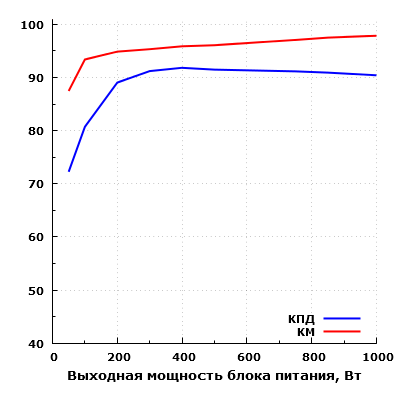
Thus, we measured the parameters of the power supply at 9 points. The highest efficiency factor (efficiency) in our case was 91.8%, with an output power of 400 W. The maximum power dissipation reached 106 W with an output power of 1000 W, which is a very insignificant value for a power supply of such power.
Temperature
In this context, with the exception of the maximum power mode, the thermal load of the capacitors remains at a low level, which is a positive factor.

We studied the operation of the power supply in a mode that can be described as formally hybrid, with control of the cooling system. The results showed that the fan turns on only when a certain temperature is reached at the temperature sensor (about 38°C) and turns off when the temperature drops to a certain threshold (about 36°C). In this mode, the fan remains turned on under typical load, starting operation for a minimum time after turning on the power supply. However, it is possible to completely stop the fan only at a minimum load, which is practically unattainable in real conditions.
This means that when operating with the fan stopped, the temperature inside the power supply will greatly depend on the ambient air temperature. Theoretically, in low temperature conditions, such as freezing temperatures, the fan could turn on at a lower frequency, which could be convenient for users working in such conditions.
Acoustic ergonomics
To measure the noise level of power supplies, we used the following method. The power supply was placed on a flat surface with a fan on top. At a distance of 0.35 meters above it, the measuring microphone of the Oktava 110A-Eco sound level meter was placed, with the help of which the noise level was measured. To create a load on the power supply, a special stand with a silent operating mode was used. The power supply was operated at constant power for 20 minutes, after which the noise level was measured.
This approach to measuring the noise level makes it possible to estimate it most accurately under conditions similar to installing the system unit on the user’s desk. Increasing the distance to the noise source or the presence of barriers with good sound insulation can also reduce the noise level at the control point, which has a positive effect on work comfort.
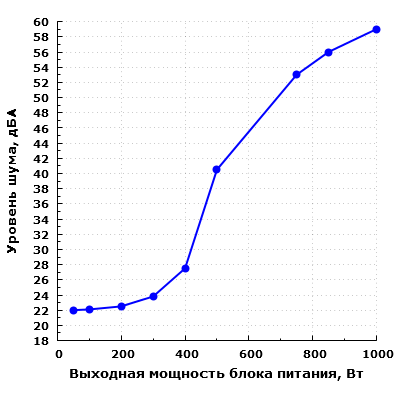
The noise level when operating in the power range up to 200 W inclusive remains at the minimum noticeable level — less than 23 dBA from a distance of 0.35 meters.
At a power of 300 W, the noise increases slightly, but for a living space during the daytime it can be considered very low.
When operating at a power of 400 W, the noise of the power supply remains at a reduced level for a living room during the day — about 28 dBA from a distance of 0.35 meters.
However, as the output power increases further, the noise level increases sharply. At a power of 500 W, the noise of this model exceeds 40 dBA, which becomes high for a living space during the daytime.
When operating at a power of 750 W, the noise becomes very high not only for residential but also for office space — more than 50 dBA, reaching almost 60 dBA at a maximum power of 1 kW.
In terms of acoustic ergonomics, this model provides comfort with an output power of up to 400 W. An assessment of the noise level of the power supply electronics was also carried out, showing that there is almost no electronic noise in standby mode, and the excess of background noise does not exceed 2 dBA.
| Power, W | Noise level from the grille side, dBA | Deviation from background level, dBA |
|---|---|---|
| 50 | 23.5 | +3.5 |
| 100 | 23.3 | +3.3 |
| 200 | 23.3 | +3.3 |
| 300 | 23.8 | +3.8 |
| 400 | 23.9 | +3.9 |
| 500 | 25.0 | +5.0 |
There are no special complaints about electronic noise.
Consumer qualities
The Formula VL-1000G5-MOD power supply has a high load capacity of the +12VDC channel, which makes it suitable for use in powerful systems with multiple video cards. However, the acoustic ergonomics at high power leave much to be desired, and only at loads up to 400 W can the noise be considered low. In real-world use, components that draw enough power to exceed 750 W will also produce significant noise. The length of the power supply wires is sufficient for most modern cases, and the wires are made in the form of strips, completely removable, which ensures ease of assembly and further operation.
Results
The technical and operational characteristics of the Formula VL-1000G5-MOD power supply, with the exception of one thing, are at a fairly good, although not outstanding, level for a mid-budget solution. This is facilitated by the high load capacity of the +12VDC channel, relatively high efficiency and moderate thermal load. However, there are certain savings on components, including the use of not the most popular capacitors, as well as a fan of unknown origin and characteristics. However, the platform used is modern, with moderate heat generation, which creates hope for a fairly long service life of the model during active use. However, noise, especially at high power, may not meet ergonomic standards, which may be unacceptable to many users.

